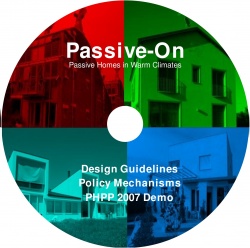Adaptation to mediterranean climate
Consolidated studies and successful examples show that Passive House Standard can be successfully adopted also in mediterranean climates, reaching high energy performance and indoor comfort conditions. High solar radiation and moderate average air temperatures help also effective performances of renewables energies systems as solar thermal and photovoltaic ones and heat pumps, to reach real passive house building with integrated renewable energy towards nearly/Net Zero Energy Buildings.
In the available documents and studies described below we can see that high thermal insulation level of building envelope it’s an effective way to reach passive house limits also in mediterranean climate. Thermal mass in building components can be useful to control cooling peak load in conditioned spaces, thanks to thermal storage effects in building slabs and interior part of walls.
External solar shading and building exposition are important too to control solar gains and allow yearly energy need for cooling lower than 15 kWh/(m2y).
When outdoor air temperatures allow, natural ventilation can be an effective strategy to guarantee summer thermal comfort conditions in passive way.
In some real cases also earth to air heat exchanger is installed in mediterranean passive house to reduce energy demand to heat and cool building ventilation air.
Research studies with their quantitative results and tools available are described below from Passive-On project, coordinated by the eERG-Group and other dedicated studies as “Passive Houses in South West Europe” by Passive House Institute.
Passive-On project is about the adaptation of the Passivhaus concept to warm climates (with the inclusion of explicit specification of summer comfort targets and cooling energy need limits, inclusion of shading, night ventilation and other summer comfort technologies) has been undertaken in the passive-on project coordinated by eERG-PoliMI research group - the end-use Efficiency Research Group of the Politecnico di Milano.
Passive-On aimed to build on the success of the Passivhaus concept by spreading the good word –and appropriate practice- towards southern and more moderate climates of Europe. A Passivhaus-compliant home consumes 80% less energy than one built to standard regulations, removing the need for conventional heating systems. The experience gained from building thousands of homes of this type in central Europe was passed on by creating guidelines and software tools for developers. Decision-makers and public bodies also benefited from strategies put together specifically for warmer climates, where the project has shown that it is not always necessary to use advanced technological solutions to build homes of high energy performance in these climatic regimes.
The tools on the adaptation and results developed within the context of the Passive-On project can be downloaded from these pages [1] and [2].
The tools include five products of the EIE Passive-On project:
- The Passivhaus Standard in European Warm Climates – Design Guidelines for comfortable low energy homes. Guidance for building homes conforming to the Passivhaus standard for architects and engineers;
- Towards passive homes - Mechanisms to support the development of the passive house market. A review of existing policies and proposals to speed up the diffusion of low energy homes in partner countries;
- Passive-On Training Module. Power point presentation and accompanying manual for promoters of low energy homes;
- Passive House Planning Package 2007 – Demo Version (old version now new and complete version with new tools and features is available here; the PHHP software demo version with reduced functionality including cooling load and cooling energy calculations;
- Passive-On Long Description. A 5 page overview of the Passive-On project and its results.
Most products and the Training Module are also translated to some degree into French, German, Italian, Portuguese and Spanish.
